Charles E W Bean, Diaries, AWM38 3DRL 606/243A/1 - 1916 - 1934 - Part 15
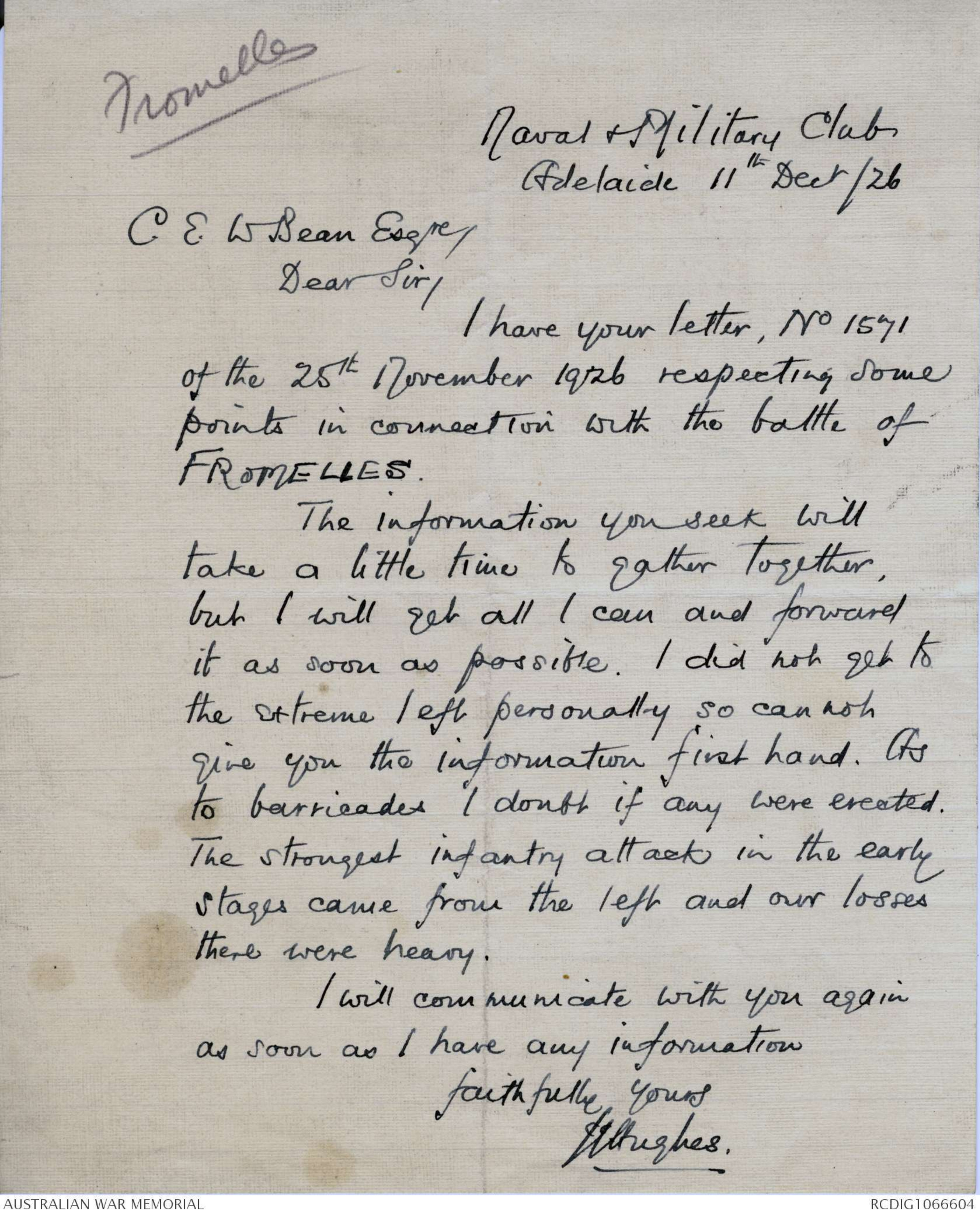
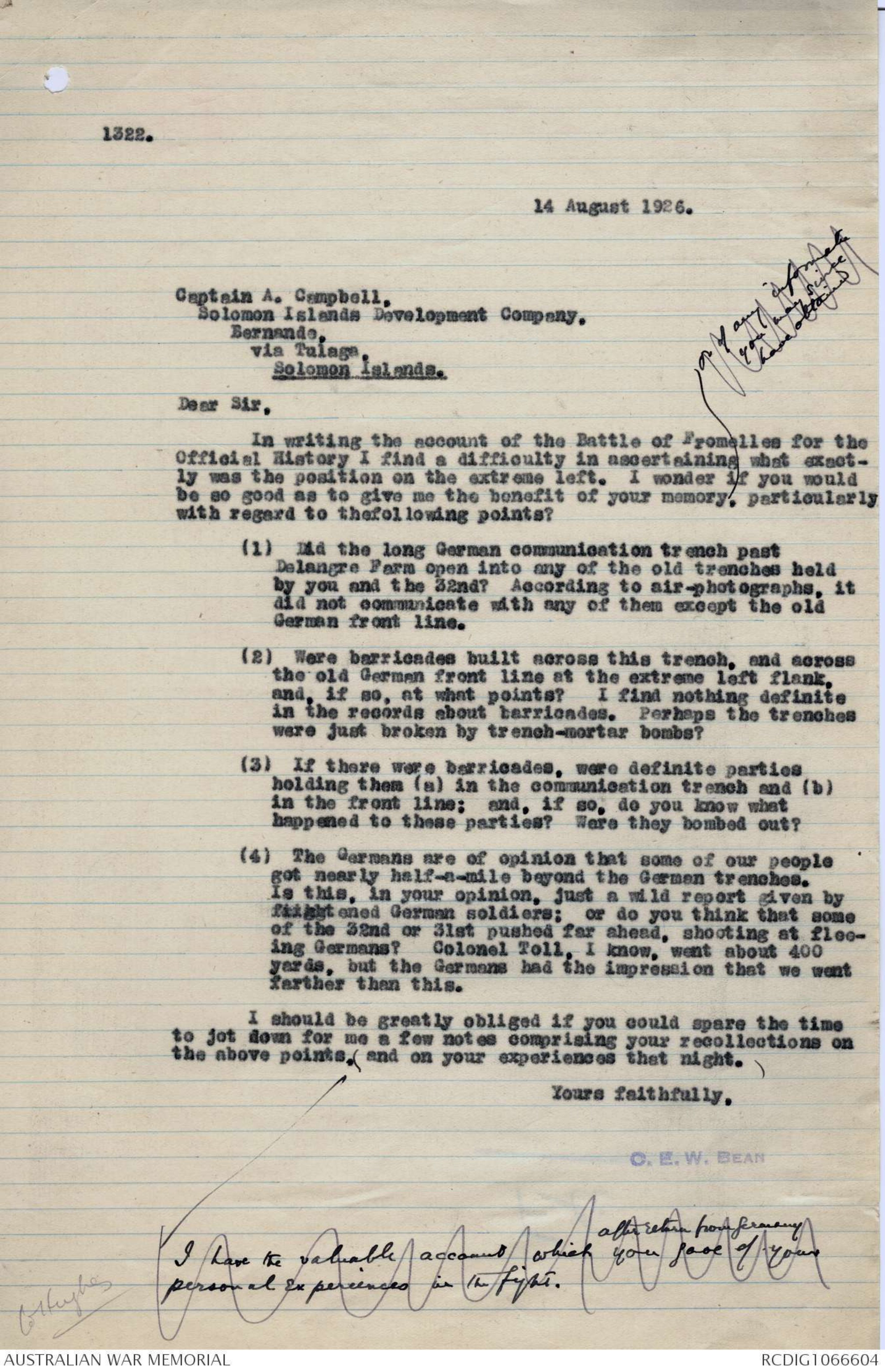
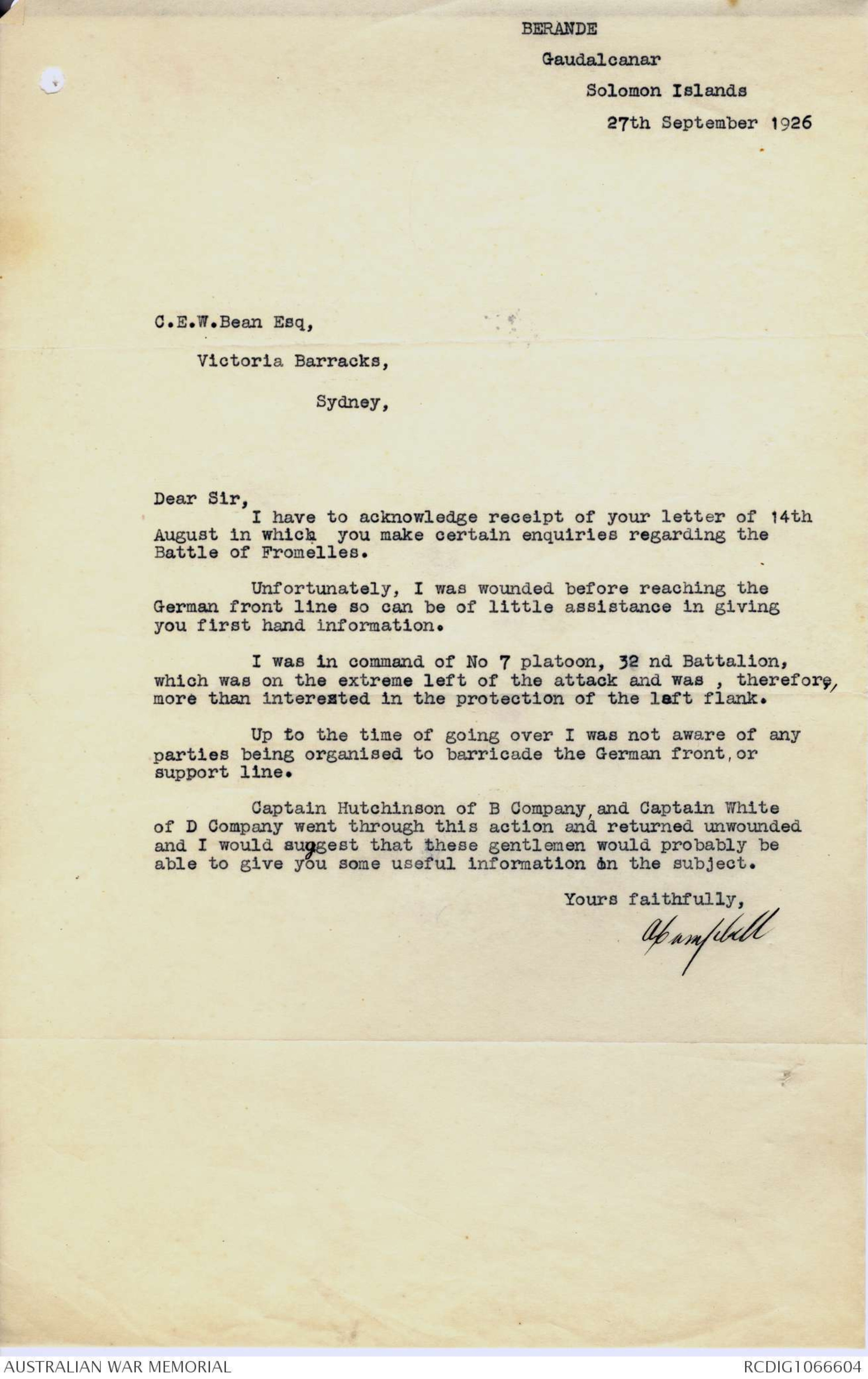
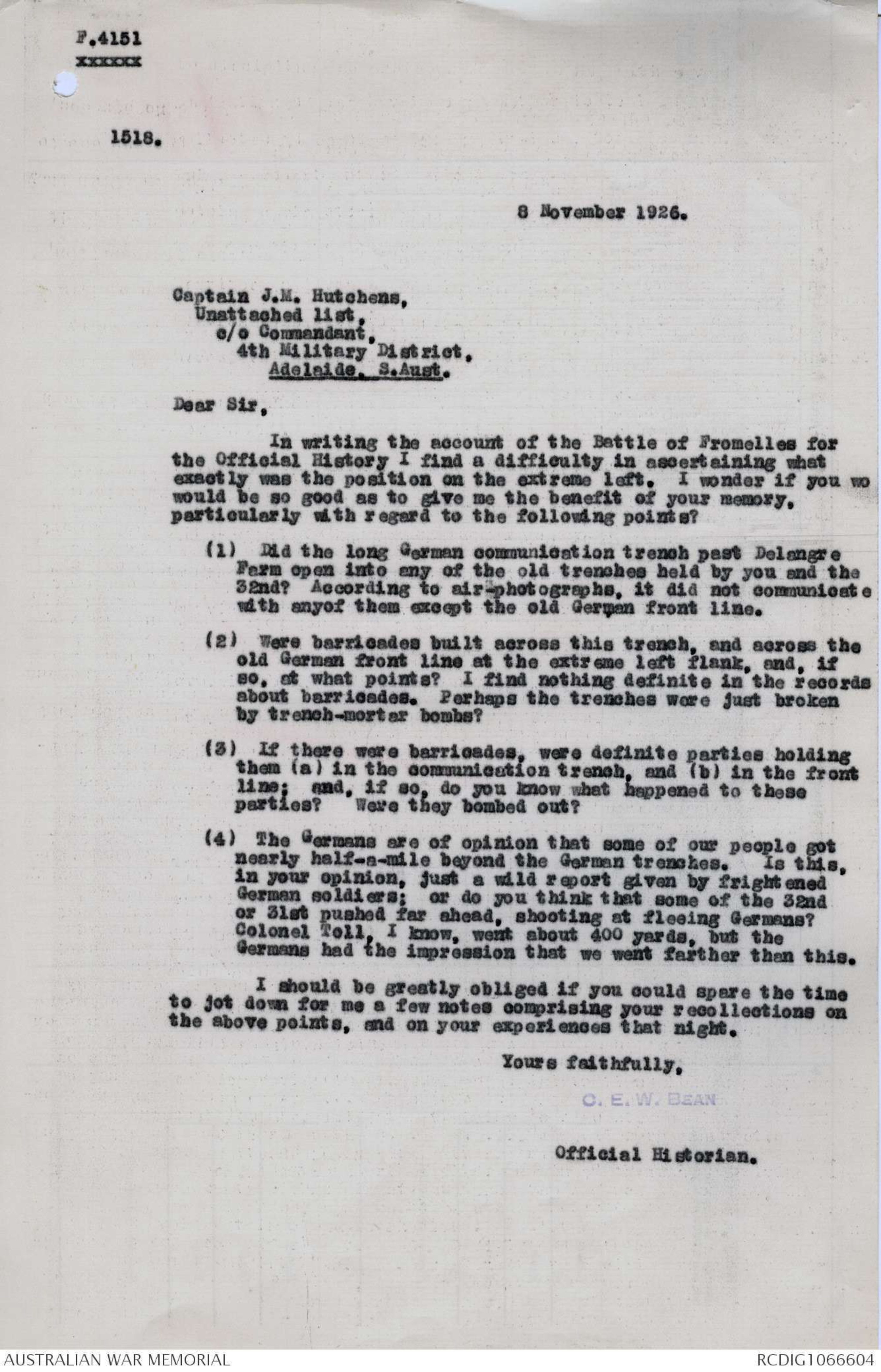
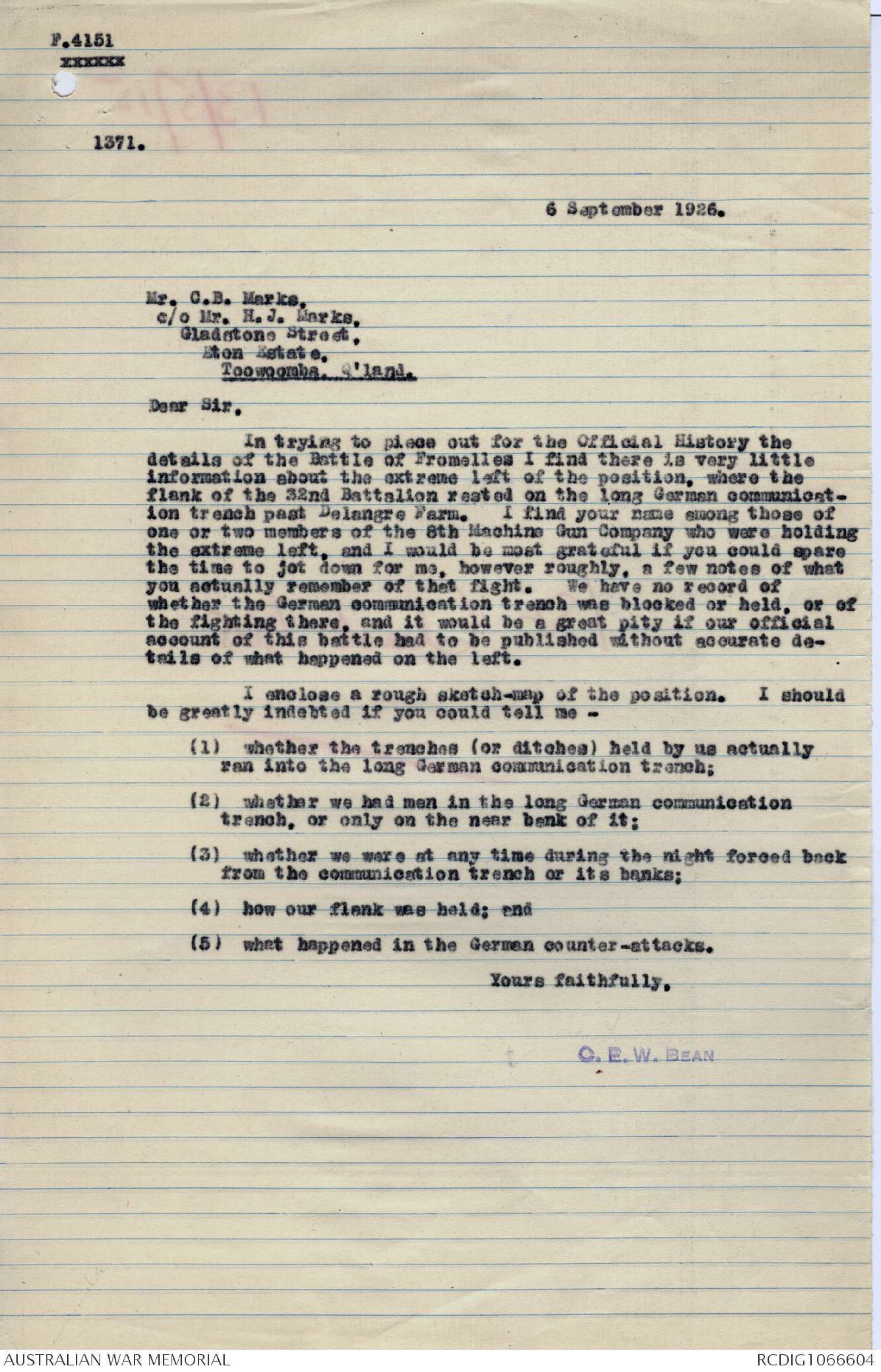
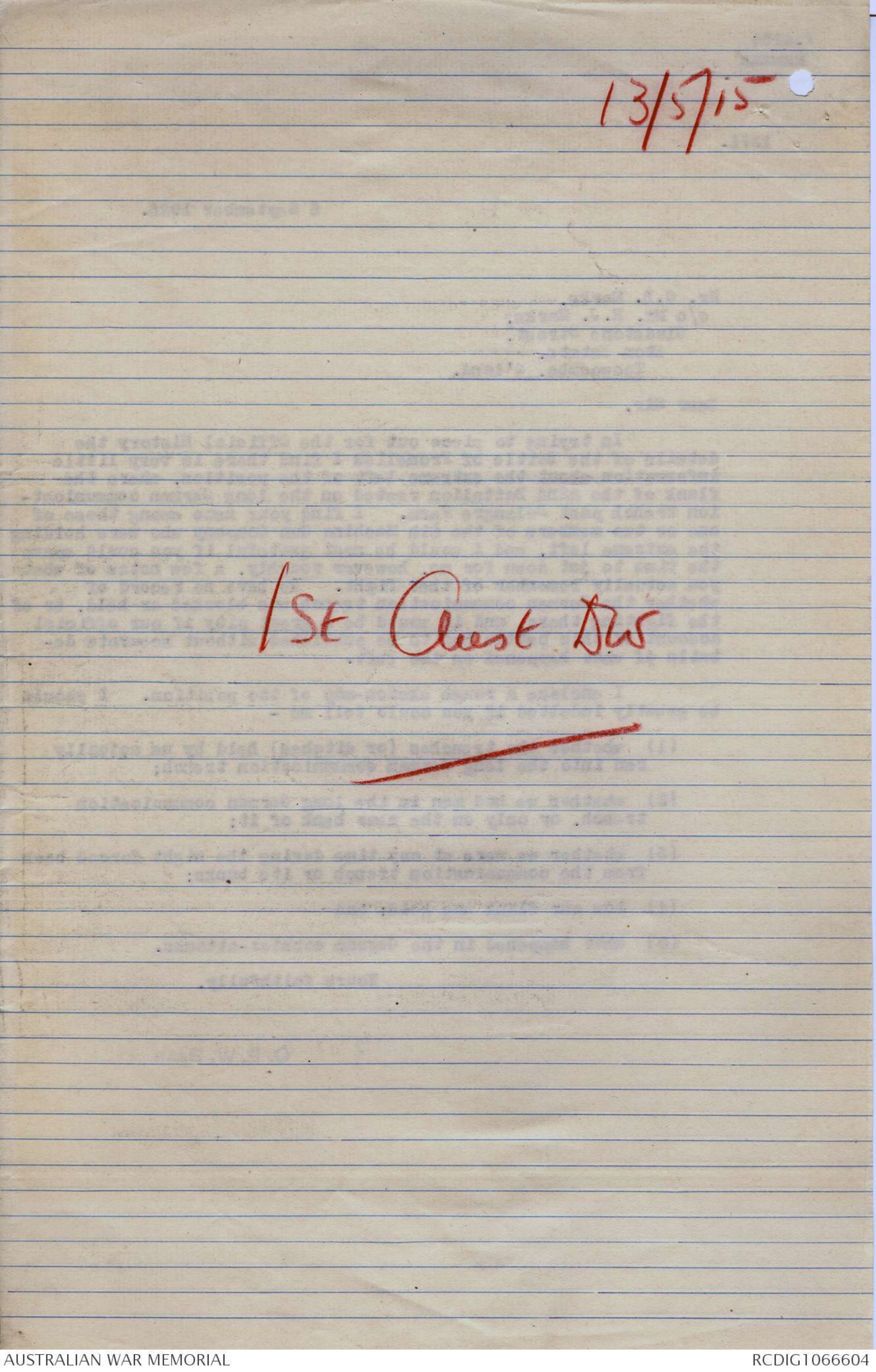
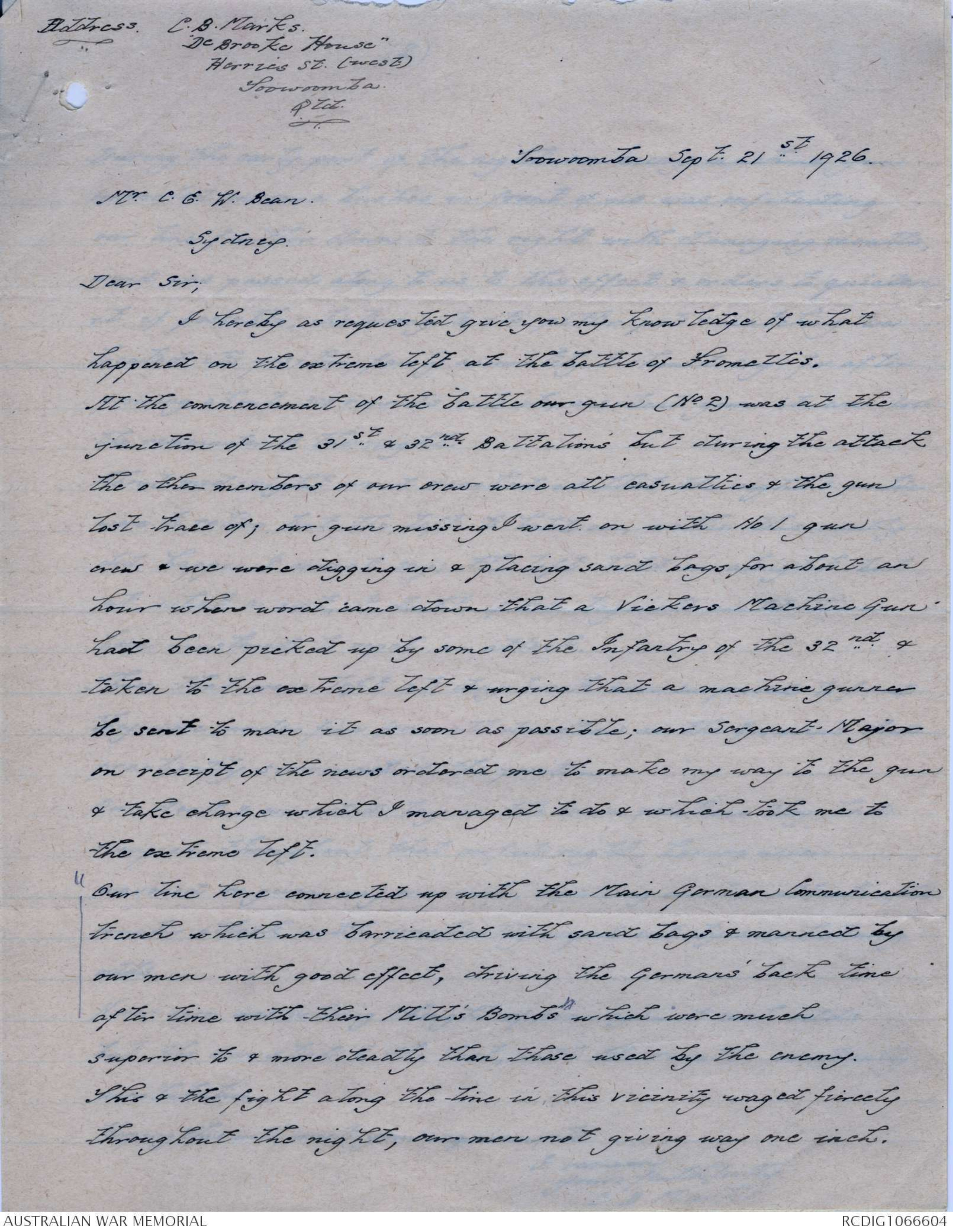
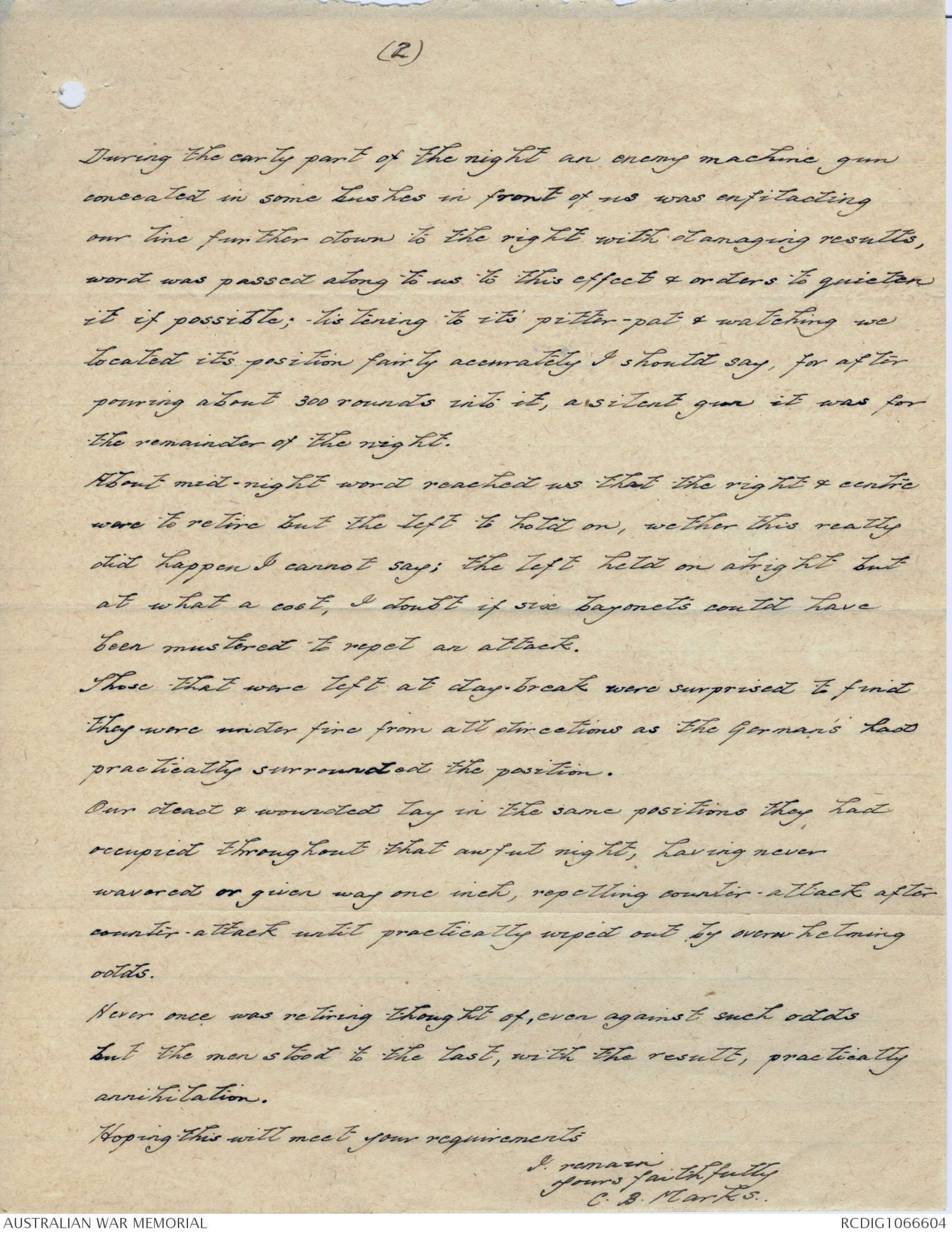

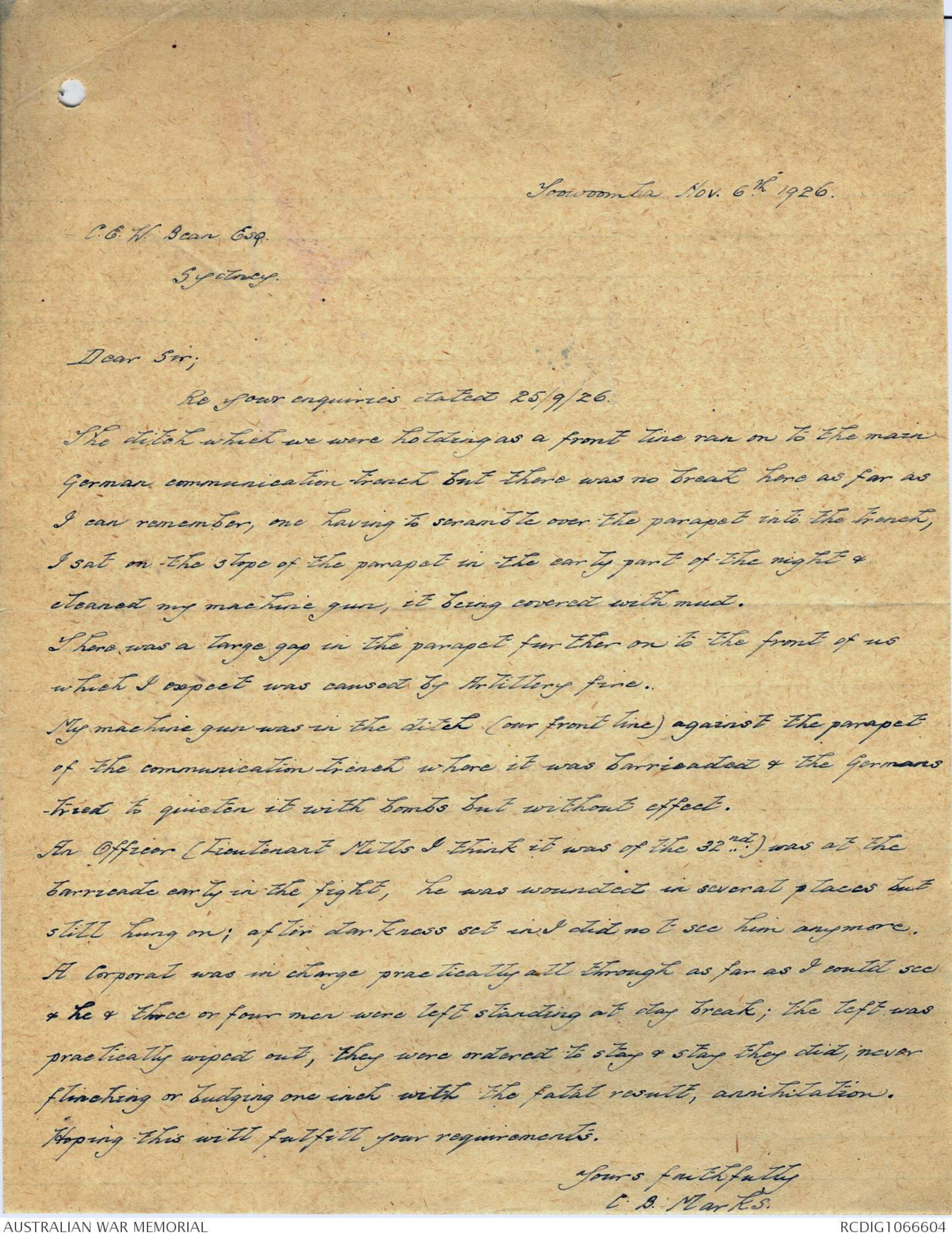
[*Fromelles*]
Naval & Military Club
Adelaide 11th Dec / 26
C E W Bean Esqre/
Dear Sir/
I have your letter, No 1571
of the 25th November 1926 respecting some
points in connection with the battle of
FROMELLES.
The information you seek will
take a little time to gather together,
but I well get all I can and forward
it as soon as possible. I did not get to
the extreme left personally so can not
give you the information first hand. As
to barricades I doubt if any were erected.
The strongest infantry attack in the early
stages came from the left and our losses
there were heavy.
I will communicate with you again
as soon as I have any information
faithfully yours
[[?]] Hughes
1322
14 August 1926.
Captain A. Campbell,
Solomon Islands Development Company,
Bernande,
via Tulage,
Solomon Islands.
Dear Sir,
In writing the account of the Battle of Fromelles for the
Official History I find a difficulty in ascertaining what exactly
was the position on the extreme left. I wonder if you would
be so good as to give me the benefit of your memory, particularly
[*or any information you may since have obtained*]
with regard to the following points?
(1) Did the long German communication trench past
Delangre Farm open into any of the old trenches held
by you and the 32nd? According to air-photographs, it
did not communicate with any of them except the old
German front Line.
(2) Were barricades built across this trench, and across
the old German front line at the extreme left flank,
and, if so, at what points? I find nothing definite.
in the records about barricades. Perhaps the trenches
were just broken by trench-mortar bombs?
(3) If there were barricades, were definite parties
holding them (a) in the communication trench and (b)
in the front line; and, if so, do you know what
happened to these parties? Were they bombed out?
(4) The Germans are of opinion that some of our people
got nearly half-a-mile beyond the German trenches.
Is this, in your opinion, just a wild report given by
frightened German soldiers; or do you think that some
of the 32nd or 3lst pushed far ahead, shooting at fleeing
Germans? Colonel Toll, know, went about 400
yards, but the Germans had the impression that we went
farther than this.
I should be greatly obliged if you could spare the time
to jot down for me a few notes comprising your recollections on
the above points, and on your experiences that night.)
Yours faithfully.
C.E.W. Bean
Col Hughes
[*I have the valuable account which after return from Germany you gave of your personal experiences in the fight.*]
BERANDE
Gaudalcanar
Solomon Islands
27th September 1926
C.E.W.Bean Esq.
Victoria Barracks,
Sydney,
Dear Sir
I have to acknowledge receipt of your letter of 14th
August in which you make certain enquiries regarding the
Battle of Fromelles.
Unfortunately, I was wounded before reaching the
German front line so can be of little assistance in giving
you first hand information.
I was in command of No 7 platoon, 32 nd Battalion,
which was on the extreme left of the attack and was, therefore,
more than interested in the protection of the left flank.
Up to the time of going over I was not aware of any
parties being organised to barricade the German front, or
support line.
Captain Hutchinson of B Company, and Captain White
of D Company went through this action and returned unwounded
and I would suggest that these gentlemen would probably be
able to give you some useful information an the subject.
Yours faithfully,
A Campbell
F.4151
xxxxx
1518.
8 November 1926.
Captain J.M. Hutchens,
Unattached list,
c/o Commandant
4th Military District,
Adelaide, S.Aust.
Dear Sir,
In writing the account of the Battle of Fromelles for
the Official History I find a difficulty in ascertaining what
exactly was the position on the extreme left. I wonder if you wo
would be so good as to give me the benefit of your memory,
particularly with regard to the following points?
(1) Did the long German communication trench past Delangre
Farm open into any of the old trenches held by you and the
32nd? According to air-photographs, it did not communicate
with anyof them except the old German front line.
(2) Were barricades built across this trench, and across the
old German front line at the extreme left flank, and, if
so, at what points? I find nothing definite in the records
about barricades. Perhaps the trenches were just broken
by trench-mortar bombs?
(3) If there were barricades, were definite parties holding
them (a) in the communication trench, and (b) in the front
line; and, if so, do you know what happened to these
parties? Were they bombed out?
(4) The Germans are of opinion that some of our people got
nearly half-a mile beyond the German trenches. Is this,
in your opinion, just a wild report given by frightened
German soldiers: or do you think that some of the 32nd
or 31st pushed far ahead, shooting at fleeing Germans?
Colonel Toll, I know, went about 400 yards, but the
Germans had the impression that we went farther than this.
I should be greatly obliged if you could spare the time
to jot down for me a few notes comprising your recollections on
the above points, and on your experiences that night.
Yours faithfully,
C.E.W. BEAN
Official Historian.
F.4151
xxxxxx
1371.
6 September 1926.
Mr. C.B. Marks,
c/o Mr. H. J. Marks,
Gladstone Street,
Eton Estate,
Toowoomba. Q'land.
Dear Sir
In trying to piece out for the Official History the
details of the Battle of Fromelles I find there is very little
Information about the extreme left of the position, where the
flank of the 32nd Battalion rested on the long German communication
trench past Delangre Farm. I find your name among those of
one or two members of the 8th Machine Gun Company who were holding
the extreme left, and I would be most grateful if you could spare
the time to jot down for me, however roughly, a few notes of what
you actually remember of that fight. We have no record of
whether the German communication trench was blocked or held, or of
the fighting there, and it would be a great pity if our official
account of this battle had to be published without accurate details
of what happened on the left.
I enclose a rough sketch-map of the position. I should
be greatly indebted if you could tell me -
(I) whether the trenches (or ditches) held by us actually
ran into the long German communication trench;
(2) whether we had men in the long German communication
trench, or only on the near bank of it:
(3) whether we were at any time during the night forced back
from the communication trench or its banks;
(4) how our flank was held; and
(5) What happened In the German Counter-attacks
Yours faithfully,
C.E.W.BEAN
13/5/15
1st Aust Div
Address. C.B. Marks.
"De Brooke House"
Herries St (west)
Toowoomba
Qld.
Toowoomba Sept 21st 1926
Mr C.E.W. Bean.
Sydney.
Dear Sir;
I hereby as requested give you my knowledge of what
happened on the extreme left at the battle of Fromelles.
At the commencement of the battle our gun (N°2) was at the
junction of the 31st & 32nd Battalions but during the attack
the other members of our crew were all casualties & the gun
lost trace of; our gun missing I went on with No 1 gun
crew & we were digging in & placing sand bags for about an
hour where word came down that a Vickers Machine Gun
had been picked up by some of the Infantry of the 32nd &
taken to the extreme left & urging that a machine gunner
be sent to man it as soon as possible; our Sergeant-Major
on receipt of the news ordered me to make my way to the gun
& take charge which I managed to do & which took me to
the extreme left.
"Our line here connected up with the main German Communication
Trench which was barricaded with sand bags & manned by
our men with good effect, driving the Germans' back time
after time with their Mill's Bombs" which were much
superior to & more deadly than those used by the enemy.
This & the fight along the line in this vicinity waged fiercely
throughout the night, our men not giving way one inch.
(2)
During the early part of the night an enemy machine gun
concealed in some bushes in front of us was enfilading
our line further down to the right with damaging results,
word was passed along to us to this effect & orders to quieten
it if possible; - listening to its' pitter-pat & watching we
located it's position fairly accurately I should say, for after
pouring about 300 rounds into it, a silent gun it was for
the remainder of the night.
About mid-night word reached us that the right & centre
were to retire but the Left to hold on, wether this really
did happen I cannot say; the Left held on alright but
at what a cost, I doubt if six bayonets could have
been mustered to repel an attack.
Those that were left at day break were surprised to find
they were under fire from all directions as the German's had
practically surrounded the position.
Our dead & wounded lay in the same positions they had
occupied throughout that awful night, having never
wavered or given way one inch, repelling counter-attack after
counter-attack until practically wiped out by overwhelming
odds.
Never once was retiring thought of, even against such odds
but the men stood to the last, with the result, practically
annihilation.
Hoping this will meet your requirements
I remain
yours faithfully
C.B. Marks.
F.4151.
xxxxxxx
1429.
25th September, 1926.
C.B.Marks, Esq.
"De Brooke House"
Herries Street (West),
Toowoomba,
Queensland.
Dear Mr. Marks,
Many thanks for your note which is exactly what is
required. When you say:
"Our line here connected up with the main German communication
trench which was barricaded with sand bags and manned
by our men with good effect, driving the Germans back time
after time with their Mill's bombs
I take it that you mean that the ditch which we were holding as a
Front line ran into the big German communication trench. Can
you tell me if this was so, or did one have to clamber into the
communication trench over its parapet? Possibly our men broke
a passage-way through during the night. Could you also tell me
whether any officer was at the barricade in the communication
trench. Was your machine-gun on the barricade, or on the trench
parapet, or beside them?
I should be most obliged if you would send me a short
note on these points.
Your sincerely.
C. E. W. Bean
Toowoomba Nov 6th 1926
C.E.W. Bean Esq
Sydney
Dear Sir;
Re your enquiries dated 25/9/26
The ditch which we were holding as a front line ran on to the main
German communication trench but there was no break here as far as
I can remember, one having to scramble over the parapet into the trench,
I sat on the slope of the parapet in the early part of the night &
cleaned my machine gun, it being covered with mud.
There was a large gap in the parapet further on to the front of us
which I expect was caused by Artillery fire.
My machine gun was in the ditch (our front tine) against the parapet
of the communication trench where it was barricaded & the Germans
tried to quieten it with bombs but without effect.
An Officer (Lieutenant Mills I think it was of the 32nd) was at the
barricade early in the fight, he was wounded in several places but
still hung on; after darkness set in I did not see him anymore.
A Corporal was in charge practically all through as far as I could see
& he & three or four men were left standing at day break; the left was
practically wiped out, they were ordered to stay & stay they did, never
flinching or budging one inch with the fatal result, annihilation.
Hoping this with fulfill requirements.
yours faithfully
C.B. Marks.
 Deb Parkinson
Deb ParkinsonThis transcription item is now locked to you for editing. To release the lock either Save your changes or Cancel.
This lock will be automatically released after 60 minutes of inactivity.